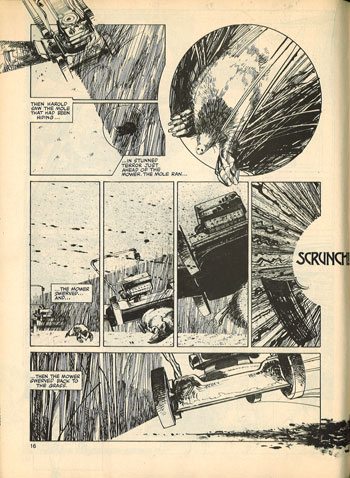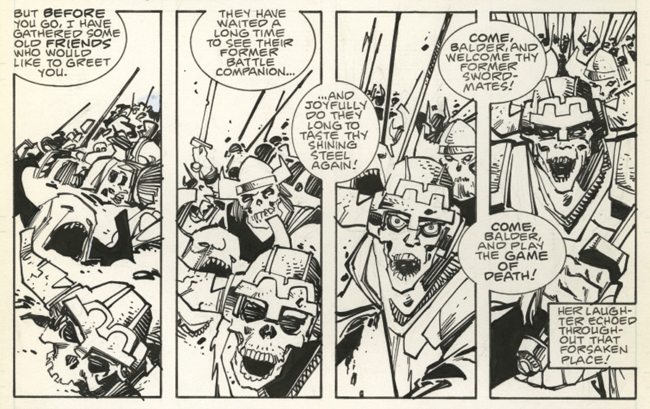ROGERS: I wanted to ask you about The Judas Coin. I’ve read a little about it here and there and was wondering if you wanted to talk about it at all.
SIMONSON: I probably haven’t said much about it in public because I was a long way from finishing it. I’m getting close. I assume it will still be half a year or more until it comes out—some time around Christmas, I suppose.

I don’t want to say too much about it, but basically it’s a long graphic novel. It began life as one of the issues of Solo that [editor] Mark Chiarello did for DC. He asked me to do an issue of Solo at a time when I was drawing a roughly 200-page Elric story with Mike Moorcock. That took me a long time to complete—I made a decision to work twice-up, which I don’t regret, but it turns out it took a lot longer to do twice-up than I thought it was going to. I wanted more room to be able to do a lot of Mike’s visualizations. He’s a phenomenally visual writer, and I said somewhere else recently, I probably could have done double the length of those issues and still had stuff left over I couldn’t fit in.
By the time that project was over, they’d wrapped Solo up. So I went in to talk to [DC co-publisher] Dan DiDio to see if I could persuade Dan to lose money on one more issue of Solo. (I don’t really know if they lost money, but, for whatever reason, they wrapped up after twelve issues.) I said, “Dan, would you be game to do one more?” I explained what I wanted to do with The Judas Coin, and he said, “Why don’t you propose that as a 96-page graphic novel?”
So I talked to [editor] Joey Cavalieri, wrote up a proposal, submitted it, and it was approved. I’ve been working on that ever since, which has been a long time.
It’s six short stories that tie together thematically and follow a kind of a through story thread. The stories involve fairly obscure DC characters, though one of them is less obscure. The timeline runs from a little after the birth of Christ up to a little less than a hundred years into the future.
I like anthologies—if you go back and read Robert W. Chambers’s The King in Yellow, his anthology, the first three or four of those stories are loosely tied together by the idea of an apocryphal play called “The King in Yellow.” There were other collections like that that I can’t remember off the bat. But they had a theme running through them, or a talisman or something of that sort, that tied the stories together. So that was my original idea for Solo, and I had worked out some plots for individual stories, individual characters.
In the end, looking back now I have to say I was extremely optimistic about how much I could have crammed into 44 pages [laughter], which is the length those books were then. I didn’t have to do any expanding to fill a 96-page hardcover, and the stories don’t feel like they’re padded. I was able to expand them to what probably should have been their original length and not have to do twelve-panel pages again, like I did back in Manhunter and which was a lot of work. [Rogers laughs.]
Anyway, that’s the nature of the project. I’ll talk more about it later down the road. But I will be finished around the time of the San Diego convention, then it'll be in DC's hands.
ROGERS: Okay, well thank you. As we go out, I just wanted to say one of the reasons that I wanted to do this interview was because one of the first comics that I remember reading is “The Lawnmower Man.”
SIMONSON: Oh, oh yes. That was a good story. That worked out very well.
ROGERS: It’s one of my favorite stories of yours. I’ve since gone back and revisited it. But it just completely terrified me from when I was about five years old onward.

SIMONSON: [Laughs.] Well, it was pretty creepy—even the written story was pretty creepy. I was just glad I was able to catch some of that.
One of the things that was funny about that story is that I never talked to him directly, never dealt with him directly, never had any connection directly to him, but Stephen King actually wrote the adaptation. We did it Marvel-style, so I had the short story, I drew up the issue in pencil at however many pages there are. Denny O’Neil was the editor I believe—he mailed the pages off to King, King wrote the script from the pages and sent them back. We had them lettered, and then I did the finished artwork on them. I guess no one had really talked to Stephen—again, like I know him—they hadn’t talked to him about scripting, so he wrote the entire script in pencil all around the margins of the art. What it meant was that when I did the finishes on that the pages, I had to erase all this Stephen King handwriting. [Rogers laughs.] And it just killed me to do it. There’s one page I have where he had enough copy that got down below the live art area, so I left some of that stuff in there. I could never prove it now, but I’ve got a page that's got some actual Stephen King handwriting on it. [Rogers laughs.] Which I thought was very cool. I love the idea that he wrote it on the art, partly because of the immediacy of it. It was just kind of charming.
ROGERS: Yeah, that’s almost like Kirby sitting there penciling in his dialogue on the margins—
SIMONSON: Yes. It was also very cool because not everybody who writes novels, short stories, prose really gets comics right off the bat. There are certain things that comics do that novels and short stories don’t and vice versa. But there were some additions that King included that made it work better as a comic than it would have worked if the adaptation had been truer to the actual story. A little more detail in some places, here and there, that makes a big difference. So I was really delighted with the script. I thought he did just a fantastic job. I only regret I never got to know him at all, so I could thank him for doing it. [Rogers laughs.]
Stephen, if you’re out there reading this, thank you very much.







